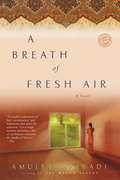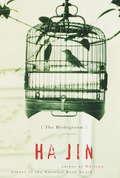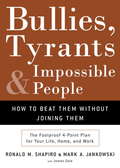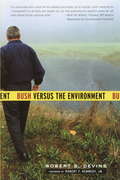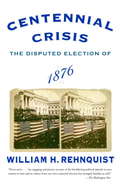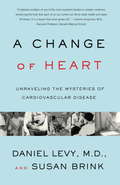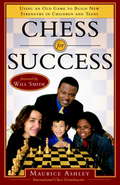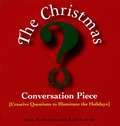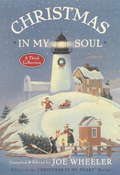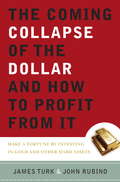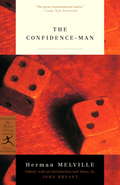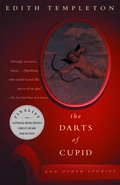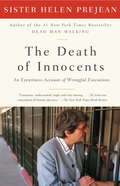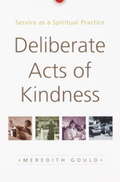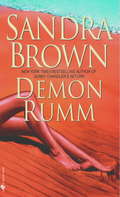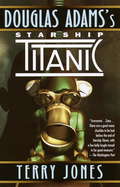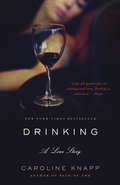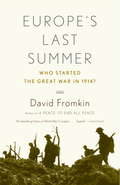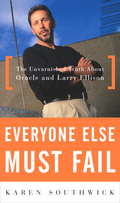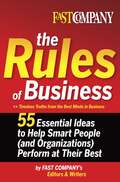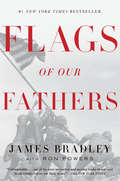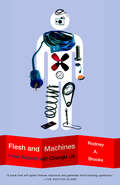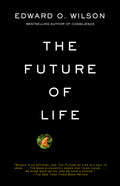- Table View
- List View
A Breath of Fresh Air
by Amulya MalladiOn the night of December 3, 1984, Anjali waits for her army officer husband to pick her up at the train station in Bhopal, India. In an instant, her world changes forever. Her anger at his being late turns to horror when a catastrophic gas leak poisons the city air. Anjali miraculously survives. Her marriage does not. A smart, successful schoolteacher, Anjali is now remarried to Sandeep, a loving and stable professor. Their lives would be nearly perfect, if not for their young son’s declining health. But when Anjali’s first husband suddenly reappears in her life, she is thrown back to the troubling days of their marriage with a force that impacts everyone around her. Her first husband’s return brings back all the uncertainty Anjali thought time and conviction had healed–about her decision to divorce, and about her place in a society that views her as scandalous for having walked away from her arranged marriage. As events unfold, feelings she had guarded like gold begin to leak away from her, spreading out into the world and challenging her once firm beliefs. Rich in insight into Indian culture and psychology,A Breath of Fresh Airresonates with meaning and the abiding power of love. In a landscape as intriguing as it is unfamiliar, Anjali’s struggles to reconcile the roles of wife and ex-wife, working woman and mother, illuminate both the fascinating duality of the modern Indian woman and the difficult choices all women must make.
The Bridegroom
by Ha JinThese twelve short stories vividly bring to life the daily dramas of Chinese men and women who are starting to feel the influence of the West while still immersed in a society that attempts to control their every move and thought. As his characters wrestle with the petty injustices and deeper heartbreaks of their constricted lives, Ha Jin celebrates their irrepressible humanity with the understated humour and disarmingly simple narrative voice that have won him widespread acclaim.
Bullies, Tyrants, and Impossible People
by Ronald M. Shapiro Mark A. JankowskiThe impossible people who make life’s journey so difficult are everywhere—at the office, in restaurants, on airplanes, living next door, members of your own family. They’re . . . • your “nothing is ever good enough” boss • the “no price is ever low enough” client • the next-door neighbor who redefines the meaning of paranoia • the maître d’ who looks through you as if you don’t exist • the father-in-law who you know is always thinking about how much better a life his Janey or Joey would have if only married to someone other than you Ron Shapiro and Mark Jankowski give you a simple and highly effective 4-point plan for dealing with all of them and more—N. I. C. E. Their system shows you how to neutralize your emotions so you don’t just react but act purposefully and wisely. It enables you to identify the type of bully, tyrant, or impossible person you’re facing—the situationally difficult (something has happened that turns an otherwise reasonable person into a temporary terror); the strategically difficult (she has empirical evidence that being difficult is a strategy that gets results); or simply difficult (being difficult is his 24/7 M. O. ). Then you’ll learn how to shape the outcome by controlling the encounter and, finally, how to get “unstuck” by exploring your options. Using colorful stories from all walks of life— “He called me the scum of the earth and it went downhill from there,” “First, lock all your vendors in a small room,” and “The boss from hell”—the authors bring their lessons to life, from business life to family life.
Bush Versus the Environment
by Robert S. DevineSince becoming president, George W. Bush has walked away from the Kyoto Protocol, pushed for oil drilling in the Arctic National Wildlife Refuge, undermined protections for endangered species and wilderness, and retreated from his campaign pledge to regulate carbon dioxide. But the president’s agenda reaches deeper than these well-known policies. InBush Versus the Environment, Robert Devine shows how the White House is quietly undermining the entire system of environmental safeguards that has developed over the past thirty years. The administration's tactics include: -Encouraging lawsuits against the federal government that challenge existing environmental laws, and then feebly defending the cases in court. -Ignoring science that doesn’t support the president's goals, and pressuring government scientists to produce the results the administration wants. -Using fuzzy math to overestimate the costs and underestimate the benefits of regulations that protect human health and the environment, which can lead to the elimination of much-needed rules. These are just a few of the administration’s strategies, which are being pursued beneath the radar of a public that overwhelmingly supports environmental protections. Bush Versus the Environmentis a compelling and important look at one of the most important issues facing America today, one that will have consequences that last long after Bush has left office. From the Trade Paperback edition.
Centennial Crisis
by William H. RehnquistNear midnight on Election Day in November 1876, the returns coming into Republican National headquarters signaled a victory for the Democratic presidential candidate, Samuel J. Tilden. But alert Republican leaders saw that if all the states still doubtful or disputed went for their candidate, Rutherford B. Hayes would be elected. Word was sent out to four southern states that their returns were crucial for a Hayes victory. Thus Chief Justice William Rehnquist begins this remarkable account of one of American's greatest political dramas, a crisis that was not resolved for nearly four months, on March 2, 1877, only two days before Inauguration Day. In his gripping story, Rehnquist tells how each party maneuvered to buy votes in the southern states, how the country slid into Congressional, judicial and public turmoil, and how the creation in January of an Electoral Commission (comprised of five Democrats, five Republicans and five Supreme Court justices) was opposed by both candidates. When that body's deciding vote was cast by Justice Joseph Bradley, public outcry reached such a fever pitch that the presidential swearing-in had to be held on a Sunday in near secrecry. Reaching beyond the history of a contentious election, the Chief Justice describes the political climate and economy of America in the 1870's, packing his narrative with biographical sketches of the central participants and opening a window on events in that decade that have long been overlooked. In a compelling epilogue we learn the occasions when Presidents, ranging from George Washington to Lyndon Johnson, have asked Supreme Court justices to arbitrate disputes, settle treaties or serve on investigating commissions. Almost always the justices were berated and attacked for their decisions. Would it be better for them to have refused the president’s request? The Chief Justice has some surprising answers.
Change of Heart
by Daniel LevyA Change of Heartis a detailed account of the revolutionary Framingham Heart study -- which, over the years, has provided conclusive evidence that cardiovascular disease is largely the result of measurable and modifiable risk factors. First begun in 1948, not long after Franklin Delano Roosevelt succumbed to a massive stroke, the study of over 5,000 citizens of Framingham, Massachusetts, changed the course of medical history. The lessons learned in Framingham allow each of us to control our risk of heart disease and stroke, two of the leading causes of death in the United States. Here is a clear-eyed and intriguing assessment of the achievements of this study and of its continuing importance to our health today.
Chess for Success
by Maurice Ashley International Chess GrandmasterMaurice Ashley immigrated to New York from Jamaica at the age of twelve, only to be confronted with the harsh realities of urban life. But he found his inspiration for a better life after stumbling upon a chess book and becoming hypnotized by the game. He would eventually break the chess world's color lines by becoming an International Grandmaster in 1999. Ashley realized that chess strategies could be used as an educational tool to help children avoid the pitfalls often associated with growing up. In this book, he serves up compelling anecdotes about how chess has positively affected young players. He also offers tips on technique, how to make the game fun for children of all ages and levels, and how to overcome the myth that chess isn't cool. Through his guidance, readers will understand how chess strategies can improve a child's mental agility, creativity, and problem-solving skills. Chess for Successis a much-anticipated resource for parents, teachers, counselors, youth workers, and chess lovers.
Chesterton
by Garry Wills"Part of a literary circle that included H. G. Wells, George Bernard Shaw, Hillaire Belloc, and Max Beerbohm, G. K. Chesterton (1874-1936) wrote essays of social criticism for contemporary journals, literary criticism (including notable books on Browning, Dickens, and Shaw), and works of theology and religious argument, but may have been best known for his Father Brown mysteries. Chesterton's interest in Catholic Christianity, first expressed in Orthodoxy, led to his conversion from Anglicanism to Roman Catholicism in 1922. His classic Saint Francis of Assisi and the equally acclaimed Saint Thomas Aquinas confirmed his reputation as a writer with the rare ability to simultaneously entertain, inform, and enlighten readers. This revised edition of Garry Wills's finely crafted biography includes updates to the text and a new Introduction by the author. "--BOOK JACKET. Title Summary field provided by Blackwell North America, Inc. All Rights Reserved
Christmas Conversation Piece
by Bret Nicholaus Paul LowrieWhat one Christmas tradition would you never want to give up? If you could spend Christmas anywhere in the world, where would you most want to be? If you could have visited the Christ child just as the Three Kings did, what would you have brought as a gift? You've been chosen to host a sensational Christmas celebration on TV: What three guests would you choose to make it the best Christmas special ever? The Christmas Conversation Pieceoffers these and many other questions to pose and ponder during a season of both deep reflection and unabashed merriment. This charming volume--the perfect stocking stuffer--will provide you, your family, and your friends with twelve days of surprising and amusing Yuletide questions. Who would you most like to meet under the mistletoe? Your answer just may change by Christmas Eve!
Christmas in My Soul
by Joe WheelerFrom the man who compiled the cherished Christmas In My Heart series comes Christmas In My Soul -- the perfect gift book for the holiday season.
The Coming Collapse of the Dollar and How to Profit From It
by James Turk John RubinoPeriodically, the global economy shifts gears in a fundamental way, turning conventional wisdom on its head and producing new categories of winners and losers among investors.
The Confidence-Man
by Herman MelvillePoorly received when first published in 1857, The Confidence Man is now considered Herman Melville's most nearly perfect work, and one that occupies a central place in the American literary tradition of masquerade and trickery. Set on April Fool's Day aboard a Mississippi steamer, this powerful and engaging novel, through the conversations of the confidence man (who may be looked on as the Devil or God), explores America and American values. Part satire, part hoax, The Confidence Man is also a dark look at the nothingness lurking beneath our beliefs and assumptionsa look at a universe in which neither God nor the Devil exists, and where Christianity is only a comforting fiction little better than an April Fool's prank.
The Darts of Cupid
by Edith TempletonWhen Edith Templeton’s stories began appearing inThe New Yorkerin the late 1950s, she quickly became a favorite of the magazine’s discerning readers. Her finely honed writing, honestly drawn heroines, and distinctive themes secured her reputation. The Dart’s of Cupidcollects seven of Templeton’s stories for the first time and reintroduces one of the truly great writers of the twentieth century. In settings ranging from a decrepit Bohemian castle between the wars to London during World War II to the Italian Riviera in the 1990s, the heroines of these stories often find themselves confronting unfathomable passsions and perplexing actions by others, but they seldom feel regret.
The Death of Innocents
by Helen PrejeanFrom the author of the national bestseller Dead Man Walking comes a brave and fiercely argued new book that tests the moral edge of the debate on capital punishment: What if we're executing innocent men? Two cases in point are Dobie Gillis Williams, an indigent black man with an IQ of 65, and Joseph Roger O'Dell. Both were convicted of murder on flimsy evidence (O'Dell's principal accuser was a jailhouse informant who later recanted his testimony). Both were executed in spite of numerous appeals. Sister Helen Prejean watched both of them die.As she recounts these men's cases and takes us through their terrible last moments, Prejean brilliantly dismantles the legal and religious arguments that have been used to justify the death penalty. Riveting, moving, and ultimately damning, The Death of Innocents is a book we dare not ignore.From the Trade Paperback edition.ng on the forensic evidence, which he claimed would exonerate him, but the courts refused. After his execution on July 23, 1997, the state destroyed the evidence. As a result, its conviction of O'Dell could never be scrutinized. "The reader of this book will be the first 'jury' with access to all the evidence the trial juries never saw," says Prejean, who accompanied both men to their executions. By using the withheld evidence to reconstruct the crimes for which these two men were convicted, Prejean shows how race, prosecutorial ambition, poverty, election cycles, and publicity play far too great a role in determining who dies and who lives.Prejean traces the historical underpinnings of executions in this country, demonstrating that it is no accident that over 80 percent of executions in the past twenty-five years have been carried out in the former slave states. She also raises profound constitutional questions about an appeals system that decides most death cases on procedural grounds without ever examining their merits.To date, 113 wrongfully convicted persons have been freed from death row. If constitutional protections-due process, assistance of counsel, and equal justice under law-are truly being respected, how is it possible that these people were convicted in the first place? And how can we accept a system so rife with error?Sister Helen Prejean takes us with her on her spiritual journey as she accompanies two possibly innocent human beings to their deaths at the hands of the state. Prejean implores us to reflect on what is perhaps the core moral issue of the death penalty debate: Honorable people disagree about the justice of executing the guilty, but can anyone argue about the injustice of executing the innocent?From the Hardcover edition.
Deliberate Acts of Kindness
by Meredith GouldAn indispensable guide to the spiritual and the practical aspects of devoting one’s time and energies to the service of others. Deliberate Acts of Kindnessis for people who are ready to supplement"random acts of kindness" with intentional acts of generosity, decency, and integrity. More than simply a handbook for volunteers, it explores the significance of service as an expression of spirituality and the commitment to something greater than oneself. Meredith Gould guides readers through their journeys, from recognizing when they are ready to answer the call to service to finding the right place to donate their time and talents. She offers invaluable advice on discovering the types of work that best suit their personalities and the areas in which they can make the greatest contributions. There is helpful information on how to get involved, as well as sensible suggestions about what to do when things go wrong in a service situation. An easy-to-read mix of tips, quotations, reflections, and short narrative passages,Deliberate Acts of Kindnesspresents a comprehensive, honest look at what service is like on a day-to-day basis. Its insights will help new volunteers and veterans alike negotiate the practical difficulties that sometimes arise and achieve the spiritual maturity that comes from answering the call to service. From the Trade Paperback edition.
Demon Rumm
by Sandra BrownIt was the publicity stunt from hell as far as Kirsten Rumm was concerned. She may have been writing the book about her late husband, aeronautical daredevil Demon Rumm, but she didn’t see the need to play host to the arrogant bad-boy actor starring in the film version’s title role. Still, for the good of the project, Kirsten agreed to share her beachfront home with the impossibly sexy screen idol. Any other woman would do anything to be in her sandals, but Kirsten wasn’t falling for Rylan North, even if he did play his role of male lead to perfection. His down-home charm, his gentleness and virile charisma, might be seducing her in every sense of the word, but he was an actor, after all. Seducing an audience was his job. Rylan could have any woman he wanted. So why was he so desperately pretending to want her? From the moment he saw her, Rylan North knew that Kirsten Rumm was the woman he’d been waiting all his life to cast as the star in his real-life love story. What did it matter if he was every woman’s fantasy if he couldn’t get Kirsten to so much as glance his way? He’d caught the look of past hurt behind her sky-blue eyes–a dark secret that shadowed the sparkle. Rylan was determined to find out what tragedy held this passionate woman back from a second chance at love even if it cost him his reputation, his career, and his life. But first he’d have to get Kirsten to act on her instincts . . . and to trust the flesh-and-blood man behind the fantasy.
The Devil Is a Gentleman
by J. C. HallmanA hundred years ago, the writer and philosopher William James wrote The Varieties of Religious Experience, a seminal work that has inspired generations of scholars and eccentrics alike. James’s book argues that the religious spirit in man is best understood through the study of its most extreme forms. Varieties was a watershed effort: a bestselling portrait of history’s pluralism and a defense of the spiritual quest, in all its guises, against the era’s increasingly secular sentiments. Today, with all the old tensions between skeptics and believers still in place, J. C. Hallman pays homage to James’s exploration of offbeat religious movements. But where James relied on the testimony and biographies of prophets and mystics, Hallman travels directly to some of America’s newest and most unusual religions, trekking from Druid circles in the mossy hills of northern California to the gleaming mother church of Scientology, from lurid satanic cellars in undisclosed locations to a professional-wrestling ministry in the fundamentalist heart of Texas. Along the way, he participates in a variety of rites and reports on a broad spectrum of beliefs. Eventually Hallman adopts James as his patron saint, spiritual adviser, and intellectual companion on the journey that will culminate in the creation of this book, a compelling combination of adventure and biography, spotted with hair-raising predicaments and rife with poignant portraits of unforgettable characters, including William James himself. The Devil Is a Gentlemanmaps the spiritual contours of modern American pluralism and examines the life and legacy of one of its most profound architects. From the Hardcover edition.
Douglas Adams's Starship Titanic
by Terry JonesIn this thoroughly satisfying and completely disorienting novel based on a story line by Douglas Adams (author of The Hitchhiker's Guide to the Galaxy), Terry Jones recounts an unforgettable tale of intergalactic travel and mishap. The saga of "the ship that cannot possibly go wrong" sparkles with wit, danger, and confusion that will keep readers guessing which reality they are in and how, on earth, to find their way out again.At the center of the galaxy, a vast, unknown civilization is preparing for an event of epic proportions: the launching of the greatest, most gorgeous, most technologically advanced Starship ever built-the Starship Titanic. An earthling would see it as a mixture of the Chrysler Building, the tomb of Tutankhamen, and Venice. But less provincial onlookers would recognize it as the design of Leovinus, the galaxy's most renowned architect. He is an old man now, and the creation of the Starship Titanic is the pinnacle achievement of his twenty-year career. The night before the launch, Leovinus is prowling around the ship having a last little look. With mounting alarm he begins to find things are not right: unfinished workmanship, cybersystems not working correctly, robots colliding with doors. How could this have happened? And how could this have happened without his knowing?Something somewhere is terribly wrong.On the following day, in an artificial event staged for the media, the Starship Titanic will leave its construction dock under autopilot and, a few days later, make its way to the terminal to pick up passengers for its maiden voyage. Although the ship will be deserted during its very first flight, it is nevertheless a major event, watched by all the galaxy's media.Hugely, magnificently, the fabulous ship eases its way forward from the construction dock, picks up speed, sways a bit, wobbles a bit, veers wildly, and just before it can do massive damage to everything around it, appears to undergo SMEF (Spontaneous Massive Existence Failure).In just ten seconds, the whole, stupendous enterprise is over. And our story has just begun.Somehow three earthlings, one Blerontin journalist, a semideranged parrot, and a shipful of disoriented robots must overcome their differences. It's the only way to save the Starship Titanic ("The Ship That Cannot Possibly Go Wrong") from certain destruction and rescue the economy of an entire planet-not to mention to survive the latest threat, an attack by a swarm of hostile shipbuilders. . . .From the Hardcover edition.
Drinking: A Love Story
by Caroline KnappFifteen million Americans a year are plagued with alcoholism. Five million of them are women. Many of them, like Caroline Knapp, started in their early teens and began to use alcohol as "liquid armor," a way to protect themselves against the difficult realities of life. In this extraordinarily candid and revealing memoir, Knapp offers important insights not only about alcoholism, but about life itself and how we learn to cope with it.
Europe's Last Summer: Who Started the Great War in 1914?
by David FromkinThe Great War not only destroyed the lives of over twenty million soldiers and civilians, it also ushered in a century of huge political and social upheaval, led directly to the Second World War and altered for ever the mechanisms of governments. And yet its causes, both long term and immediate, have continued to be shrouded in mystery. In EUROPE'S LAST SUMMER, David Fromkin reveals a new pattern in the happenings of that fateful July and August, which leads in unexpected directions. Rather than one war, starting with the assassination of Archduke Franz Ferdinand, he sees two conflicts, related but not inseparably linked, whose management drew Europe and the world into what The Economist described as early as 1914 as 'perhaps the greatest tragedy in human history'.
Everyone Else Must Fail: The Unvarnished Truth About Oracle and Larry Ellison
by Karen SouthwickKaren Southwick’s unauthorized account provides the full story of Larry Ellison’s brilliant, controversial career. Ellison’s drive and fierce ambition created Oracle out of the dust and built it into one of America’s great technology companies, but his unpredictable management style keeps it constantly on the edge of both success and disaster. The hostile bid for PeopleSoft is just the most recent example. With one clever strategic move, Larry Ellison threw much of the business software field into play.The saying “It’s not enough that I succeed, everyone else must fail” has been so often used by or associated with Ellison that most people think it originated with him. It’s actually attributed to Genghis Khan, but it’s a dead-on way to describe not only the way Ellison thinks about competitors but the way he runs Oracle. His weapons are not marauding hordes, but Oracle’s possession of database technology that is crucial for keeping mission-critical information flows working at thousands of organizations, corporations, nonprofits, and government agencies. Inside Oracle, Ellison has time and again systematically purged key operating, sales, and marketing people who got too powerful for his comfort. Most notable was Ray Lane, Oracle’s president for nine years, who was widely credited with bringing order out of the chaos that was Oracle in the early nineties and growing it into a ten billion dollar company. Ellison got rid of the one key person who was building confidence with Wall Street, business partners, and customers that Oracle was no longer flying by the seat of its pants and had its act together. Ellison’s mania for absolute control and his inability to coexist with the very lieutenants who bring much-needed stability to the company have brought Oracle to the brink of collapse before, and may well do it again. Ellison is a throwback to an earlier, much more freewheeling version of capitalism, the kind practiced by the nineteenth-century robber barons who ran their companies as private fiefdoms. Larry Ellison is one of the most intriguing and dominant leaders of a major twenty-first-century corporation, and Everyone Else Must Fail raises the question of whether Oracle’s products and the reliance placed in them by so many are too important to be subject to the whims of one man. While giving credit to Ellison’s brilliance and devotion, the book sounds a warning about an ingenious man’s tendency to be his own company’s worst enemy.
Fast Company The Rules of Business: 55 Essential Ideas to Help Smart People (and Organizations) Perform At Their Best
by Fast Company's Editors and WritersFrom The Rules of BusinessRule #1 The first rule of business is the same as the first rule of life: Adapt or die."What gets measured, gets done."--Peter DruckerRule #8 Nothing is more overrated than a new idea. Ideas by themselves are worthless. It's what you do with them that matters."Bet on the jockey, not on the horse." --Malcolm Forbes "Best practices usually aren't."--Christopher Locke, co-author, The Cluetrain ManifestoRule #49 If it is not right, don't do it; if it is not true, don't say it. "If you think you're too small to have an impact, try going to bed with a mosquito in the room."--Dame Anita Roddick, founder, The Body ShopIn THE RULES OF BUSINESS, Fast Company's renowned editor in chief, John Byrne and the writers and editors of Fast Company, distill the major ideas and principles of the world of business into fifty-five essential rules. These rules are elaborated on and enhanced by quotes and insights from over 200 business leaders, practitioners, and thinkers into what is sure to be an essential desk reference for managers, professionals, and executives-to-be.Published on the tenth anniversary of the magazine, FAST COMPANY'S THE RULES OF BUSINESS features the essential principles behind today's most important business topics, from customer service to innovation, from strategic thinking to leadership and management. The book introduces each category with a two-page commentary, and weaves two to four essential rules throughout every chapter. At the end of each chapter a boxed, bulleted "Fast Take" section gives readers specific takeaways they can use in their day-to-day work. The heart of each chapter, however, is the quotes and insights on the subject culled from the great minds in business, both living and historical--leaders and thinkers such as Machiavelli and Jack Welch, Adam Smith and his invisible hand and Tom Peters on marketing Me, Inc., Michael Porter on (what else?) strategy and A.G. Lafley, Jeff Bezos on the perils of hiring the wrong person and Bill Gates on the value of information technology, Anne Mulcahy and Warren Buffett, and many more.FAST COMPANY'S THE RULES OF BUSINESS is the ultimate desk reference.
Flags of Our Fathers: A Young People's Edition (Playaway Adult Nonfiction Ser.)
by James Bradley Ron PowersIn this unforgettable chronicle of perhaps the most famous moment in American military history, James Bradley has captured the glory, the triumph, the heartbreak, and the legacy of the six men who raised the flag at Iwo Jima. Here is the true story behind the immortal photograph that has come to symbolize the courage and indomitable will of America. In February 1945, American Marines plunged into the surf at Iwo Jima—and into history. Through a hail of machine-gun and mortar fire that left the beaches strewn with comrades, they battled to the island's highest peak. And after climbing through a landscape of hell itself, they raised a flag. Now the son of one of the flagraisers has written a powerful account of six very different young men who came together in a moment that will live forever. To his family, John Bradley never spoke of the photograph or the war. But after his death at age seventy, his family discovered closed boxes of letters and photos. InFlags of Our Fathers, James Bradley draws on those documents to retrace the lives of his father and the men of Easy Company. Following these men's paths to Iwo Jima, James Bradley has written a classic story of the heroic battle for the Pacific's most crucial island—an island riddled with Japanese tunnels and 22,000 fanatic defenders who would fight to the last man. But perhaps the most interesting part of the story is what happened after the victory. The men in the photo—three were killed during the battle—were proclaimed heroes and flown home, to become reluctant symbols. For two of them, the adulation was shattering. Only James Bradley's father truly survived, displaying no copy of the famous photograph in his home, telling his son only: "The real heroes of Iwo Jima were the guys who didn't come back. " Few books ever have captured the complexity and furor of war and its aftermath as well asFlags of Our Fathers. A penetrating, epic look at a generation at war, this is history told with keen insight, enormous honesty, and the passion of a son paying homage to his father. It is the story of the difference between truth and myth, the meaning of being a hero, and the essence of the human experience of war.
Flesh and Machines: How Robots Will Change Us
by Rodney A. BrooksAre we really on the brink of having robots to mop our floors, do our dishes, mow our lawns, and clean our windows? And are researchers that close to creating robots that can think, feel, repair themselves, and even reproduce? Rodney A. Brooks, director of the MIT Artificial Intelligence Laboratory believes we are. In this lucid and accessible book, Brooks vividly depicts the history of robots and explores the ever-changing relationships between humans and their technological brethren, speculating on the growing role that robots will play in our existence. Knowing the moral battle likely to ensue, he posits a clear philosophical argument as to why we should not fear that change. What results is a fascinating book that offers a deeper understanding of who we are and how we can control what we will become.
The Future of Life
by Edward O. WilsonOur world is far richer than previously conceived, yet so ravaged by human activity that half its species could be gone by the end of the present century. These two contrasting themes - unexpected magnificence and underestimated peril - have originated during the past two decades of research. In this timely and important new book, one of our greatest living scientists describes exactly what treasures of the natural world we are about to lose forever and what we can do right now to save them. Destruction of natural habitats, the rampant spread of invasive species, pollution, uncontrolled population growth and over harvesting are the main threats to our natural world. Wilson explains how each of these elements works to undo the web of life that supports us, and why it is in our best interests to stop it. The Future of Life is a magisterial accomplishment - both a moving description of the world's astonishing animals and plants and a guidebook for the protection of all its species, including our own.
